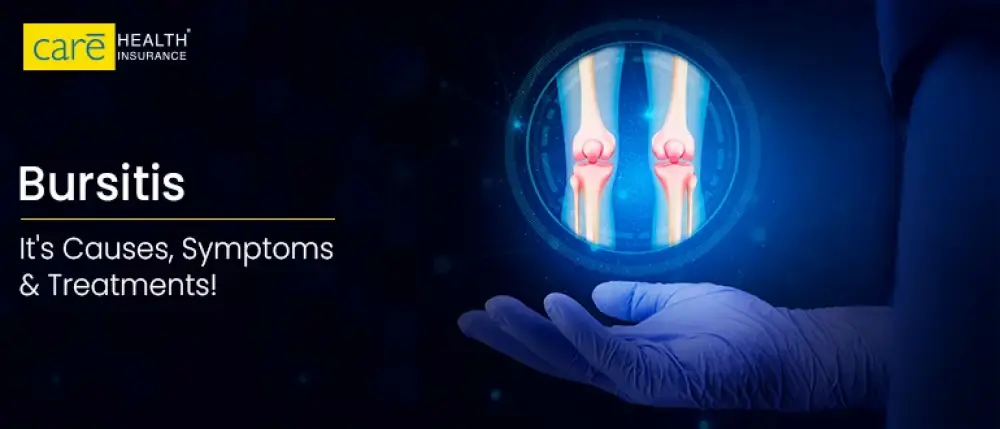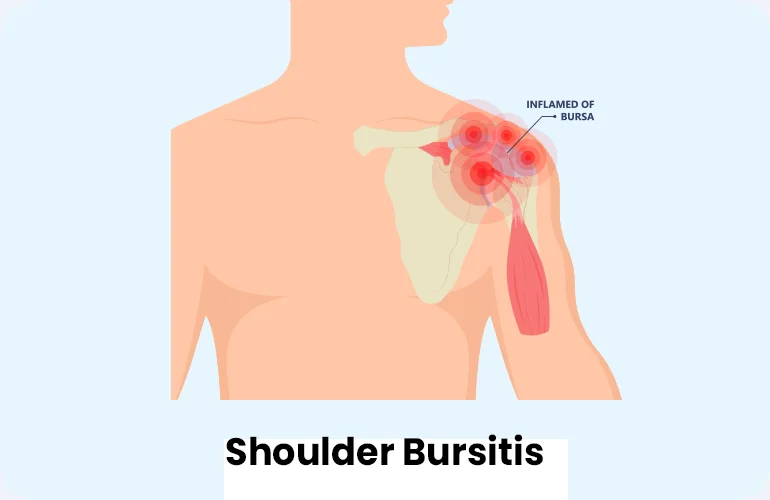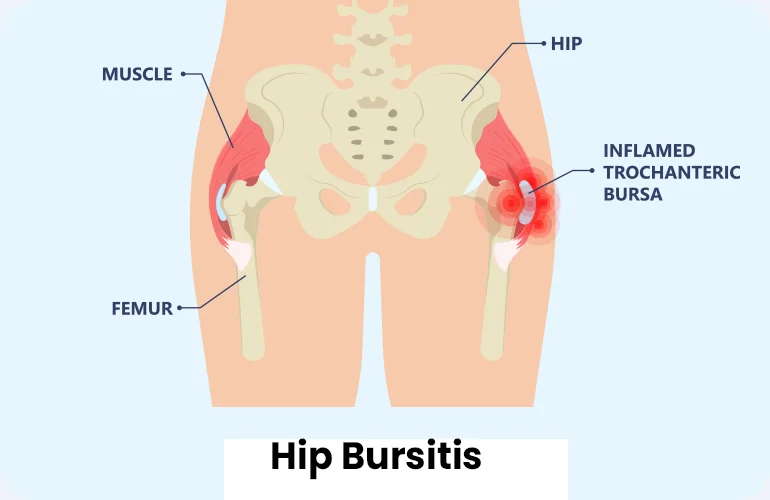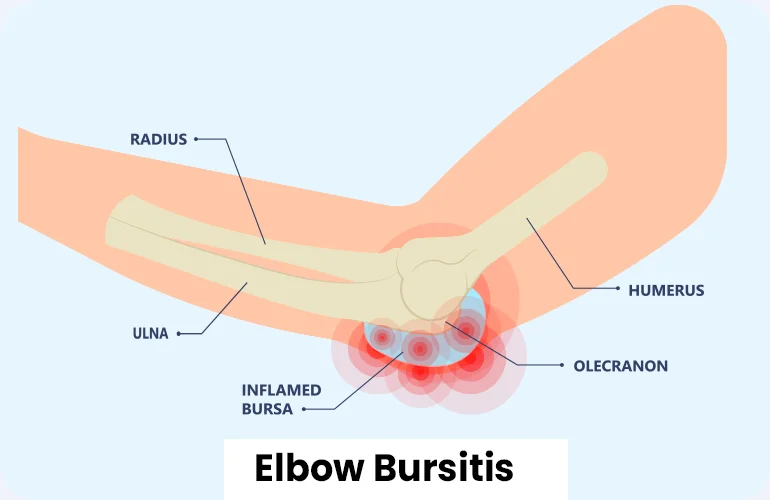Subscribe to get weekly insights
Always stay up to date with our newest articles sent direct to your inbox
Published on 18 Jul, 2025
Updated on 21 Jul, 2025
148 Views
4 min Read

Written by Sejal Singhania
Reviewed by Akhil Pillai
favorite2Likes
Ever felt sharp pain in the knee, hip, or shoulder after a day of sitting too long? You must ignore it by saying, "I am just getting old". But what if your joints are screaming for help, and the culprit could be bursitis.
Whether you're an athlete, a full-time worker, or a daily wage labourer, bursitis can affect anyone. The good news is that it's treatable, manageable, and most importantly, preventable with the right know-how. So let's learn more about bursitis and its effects on the human body.
Bursitis is a painful condition characterized by the inflammation of one or more bursae. Small, fluid-filled sacs called bursae act as cushions between muscles, tendons, and bones close to joints. Inflammation causes the affected joint to become painful, swollen, and stiff. Bursitis can affect any area of the body, including the shoulder, elbow, hip, knee, and heel, and it can be acute (sudden onset) or chronic (long-term), depending on the underlying cause and duration of inflammation.
Bursitis can affect different areas of your body, and each type is usually named after the part it affects. Here are some of the more common types of bursitis you might come across:

This kind of bursitis, also known as subacromial bursitis or shoulder impingement syndrome, affects the bursa that lies between the rotator cuff tendons and the acromion (a bony prominence on the shoulder blade).

Hip bursitis, also called trochanteric bursitis, is a painful ailment caused by inflammation of the hip joint's bursae, which are tiny sacs filled with fluid. During movement, these bursae lessen friction between bones, tendons, and muscles by cushioning and lubricating the area. When inflamed, they cause discomfort and stiffness in the hips.

Shoulder bursitis is a painful ailment resulting from inflammation of the bursae that cushions the shoulder joint. It frequently arises from injuries, infringement, or underlying diseases like arthritis. Physical therapy is essential to recovery, and other treatments like rest, ice packs, and medication are used to reduce pain and inflammation.

Heel bursitis is an inflammation that causes pain at the back of the heel. It is frequently caused by overuse or injury to the heel and ankle, such as excessive walking, jogging, or running. Physical therapy and medication both play important roles in the healing process.

Elbow bursitis, also known as olecranon bursitis, is a disorder that causes inflammation of the olecranon bursa, a fluid-filled sac located near the elbow's tip. This inflammation leads to elbow pain, edema, and restricted range of motion. It is commonly caused by repetitive actions, direct trauma, or chronic elbow pressure.
Depending on where it happens and the severity of the illness, bursitis symptoms may vary. If you do not treat bursitis or keep doing things that aggravate it, your symptoms can get worse over time. However, some common symptoms of bursitis are:
Before you blame your age or workout, let's find what is the sudden cause of your joint pain. Several triggers can lead to bursitis, such as:
Your doctor will ask you about your symptoms and perform a physical examination to see whether the joint is swollen or not. Additionally, you may also undergo the following tests:
Pro Tip: While you're looking after your joints, remember to also prioritise your overall health. Choosing a best medical insurance plan can be like having a helpful safety net ready when unexpected joint or muscle issues happen. From doctor visits to getting diagnostic tests, insurance can make your recovery process smoother and keep your finances peaceful.
Bursitis treatment often focuses on symptom relief, inflammation reduction, and addressing the condition's underlying cause. The following treatments may be available, depending on the place and severity of bursitis:
Here are some simple habits to protect you from bursitis:
Bursitis can lead to uncomfortable swelling in the fluid-filled sacs that cushion your joints. It often happens because of repetitive motions, pressure, injury, or infection. Fortunately, it usually gets better on its own, but it's a good idea to see your doctor if you have a fever, noticeable swelling or redness, a rash or bruising, or if the pain makes it hard to move your joint. Because a little prevention today can save you from a lot of "Ouch" moments tomorrow.
Disclaimer: The above information is for reference purposes only. Kindly consult your general physician for verified medical advice. Health insurance benefits are subject to policy terms and conditions. See policy documents for details.
Thyroid : मामूली नहीं हैं महिलाओं में थायराइड होना, जानें इसके लक्षण और घरेलू उपचार Vipul Tiwary in Diseases
शुगर कंट्रोल कैसे करे? जानें, डायबिटीज में क्या खाना चाहिए Vipul Tiwary in Health & Wellness
हाई ब्लड प्रेशर को तुरंत कंट्रोल कैसे करें? देखें इसके उपाय Vipul Tiwary in Diseases
पैरों में दर्द किस कमी से होता है? जानें, इसके घरेलू इलाज Vipul Tiwary in Health Insurance Articles
Cold Hands? Act Immediately Against Raynaud’s Phenomenon Jagriti Chakraborty in Diseases
Understanding Azotemia: Meaning, Causes, Treatment & ICD 10 Guide Leena Khowal in Diseases
Leukaemia vs. Lymphoma Breakdown: What Sets Them Apart Leena Khowal in Diseases
When Silent Clots Threaten Your Life: DVT Pratham Gupta in Diseases
The majority of people recover from bursitis in a matter of weeks, making it typically a temporary condition. However, the underlying cause, severity, and potential for chronicity can all affect how long it lasts.
No, bursitis and arthritis are not the same, though both can cause joint pain. Bursitis is inflammation of a bursa, a fluid sac cushioning joints, bones, tendons, and muscles. Arthritis includes over 100 conditions causing joint inflammation and pain, often from cartilage breakdown.
Untreated bursitis can cause decreased range of motion, persistent pain, and an infection risk. In some cases, it can lead to serious outcomes such as sepsis or septic shock, which can be life-threatening.
Bursitis is most frequently caused by repetitive actions or postures that strain the bursae around a joint.
Always stay up to date with our newest articles sent direct to your inbox
Loading...